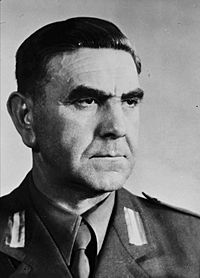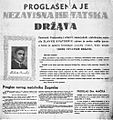Ante Pavelić facts for kids
Quick facts for kids
Ante Pavelić
|
|
|---|---|

Pavelić in Ustaše uniform in 1942
|
|
| Poglavnik of the Independent State of Croatia | |
| In office 10 April 1941 – 8 May 1945 |
|
| Monarch | Tomislav II (1941–1943) |
| Prime Minister | Himself (1941–1943) Nikola Mandić (1943–1945) |
| Preceded by | Position established |
| Succeeded by | Position abolished |
| 1st Prime Minister of the Independent State of Croatia | |
| In office 16 April 1941 – 2 September 1943 |
|
| Monarch | Tomislav II |
| Preceded by | Position established |
| Succeeded by | Nikola Mandić |
| 2nd Minister of Armed Forces of the Independent State of Croatia | |
| In office 4 January 1943 – 2 September 1943 |
|
| Prime Minister | Himself |
| Preceded by | Slavko Kvaternik |
| Succeeded by | Miroslav Navratil |
| 1st Foreign Minister of the Independent State of Croatia | |
| In office 16 April 1941 – 9 June 1941 |
|
| Monarch | Tomislav II |
| Prime Minister | Himself |
| Preceded by | Position established |
| Succeeded by | Mladen Lorković |
| Member of the Yugoslav Parliament | |
| In office 11 September 1927 – 7 January 1929 |
|
| Monarch | Alexander I |
| Prime Minister | Velimir Vukićević (1927–1928) Anton Korošec (1928–1929) |
| Constituency | Zagreb |
| Personal details | |
| Born | 14 July 1889 Bradina, Konjic, Condominium of Bosnia and Herzegovina, Austria-Hungary |
| Died | 28 December 1959 (aged 70) Madrid, Spain |
| Resting place | Saint Isidore Cemetery, Madrid, Spain |
| Nationality | Croatian |
| Political party | Ustaše (1929–1945) |
| Other political affiliations |
Party of Rights (1910–1929) Croatian Statehood Party (1950) Croatian Liberation Movement (1956–1959) |
| Alma mater | University of Zagreb |
| Occupation | Politician |
| Profession | Lawyer |
| Signature | |
Ante Pavelić (born 14 July 1889 – died 28 December 1959) was a Croatian politician. He was a key figure in the Ustaše movement, an extremist group that supported a form of fascism and nationalism. During World War II, he became the leader, known as Poglavnik (Head), of the Independent State of Croatia. This state was a puppet government, meaning it was controlled by Nazi Germany.
Contents
Early Life and Education
Ante Pavelić was born in Bradina, a small village in what was then Austria-Hungary. His family later moved to Bosnia. As a young man, he moved to Zagreb to study law at the University of Zagreb. Even in his youth, he was involved in extremist political groups. He became a member of the "Frankovci" organization.
In 1919, he served as the temporary secretary of the Pure Party of Rights. He was arrested in 1921 with other party members. He defended them in court, but they lost the case. Pavelić was a strong supporter of Croatian independence.
Political Beginnings (1920s and 1930s)
In the early 1920s, Pavelić started making connections with Croatian people living outside the country. He also formed ties with the Macedonian extremist group IMRO. In 1927, he worked as a lawyer defending Macedonian extremists in a trial.
He was elected to the Zagreb city council in 1927. He served as the secretary for the Party of Rights until 1929. When Alexander I of Yugoslavia established a royal government in Yugoslavia, Pavelić left the country. He was later sentenced to death in his absence for his role in anti-Serb protests.
After leaving Yugoslavia, Pavelić helped create the Ustaše, an extremist group. They set up training camps in Italy and Hungary. In 1933, the Ustaše tried to invade Yugoslavia by sea, but they failed. This failure may have led to the decision to assassinate King Alexander I.
On 9 October 1934, King Alexander I of Yugoslavia was killed in Marseilles, France. The French Foreign Minister, Louis Barthou, was also killed. This assassination was planned by the Ustaše.
World War II and the Independent State of Croatia
Pavelić stayed in Italy until World War II began. As the leader of the Ustaše, he was responsible for terrible actions against Serbs, Jews, Roma people, and Croats who opposed his rule. These actions were so extreme that they are considered genocide, which means trying to wipe out a whole group of people.
The Ustaše government, led by Pavelić, was one of the most violent Nazi-controlled states in Europe. German and Italian records from the war show the cruelty used against civilians. Even German officers were shocked by the Ustaše's actions. They sometimes tried to stop the violence.
The Ustaše aimed to eliminate a large part of the Serb population. They wanted to kill one-third, force another third to leave, and make the last third convert to Catholicism. They succeeded in killing a significant number of Serbs. A German report from 1942 stated that about 300,000 Orthodox Serbs had been killed or tortured by the Ustaše.
The Vatican did not officially recognize Pavelić's government. However, the Church did not condemn the violence and forced conversions. Soon after he came to power in April 1941, Pavelić had a private meeting with Pope Pius XII in Rome. This meeting was criticized by many.
Pavelić remained loyal to Adolf Hitler until the end of the war. A German official reported that Pavelić wanted Germany to recognize Croatia. He also wanted to thank Hitler in person and promised to "live and die for the Fuehrer." Pavelić was responsible for the deaths of hundreds of thousands of people during his time in power.
After the War
In May 1945, after the war ended, Pavelić fled to Austria. He then went to Rome, where he was hidden by members of the Roman Catholic Church. This is shown in declassified US intelligence documents.
Six months later, he escaped to South America. He arrived in Argentina using secret escape routes, known as "ratlines." In Argentina, he became a security advisor to Juan Perón, the country's leader. Perón allowed many Croatians to enter Argentina, including those who had worked with the Nazis and those who opposed the new communist government in Yugoslavia.
On 10 April 1957, Pavelić was shot and badly wounded in Buenos Aires. The attack was thought to be by Yugoslav intelligence, but it could also have been revenge from a rival group. Despite being seriously hurt, Pavelić did not go to the hospital. The Argentine government later agreed to send him back to Yugoslavia, so he went into hiding.
His exact location was unknown for a while. It was later learned that he had been given safety in Spain. Ante Pavelić died on 28 December 1959, in a German hospital in Madrid. His death was reportedly due to complications from the bullet wound he received earlier.
Images for kids
-
Ante Pavelić (left) and German Foreign Minister Joachim von Ribbentrop in June 1941
-
Ante Pavelić and Benito Mussolini in 1941 when Italy recognized Croatia as a sovereign state
See also
 In Spanish: Ante Pavelić para niños World War II Ustaše Jure Francetić Croatian Liberation Movement
In Spanish: Ante Pavelić para niños World War II Ustaše Jure Francetić Croatian Liberation Movement







